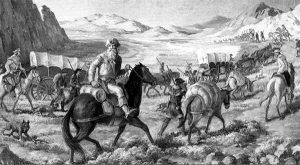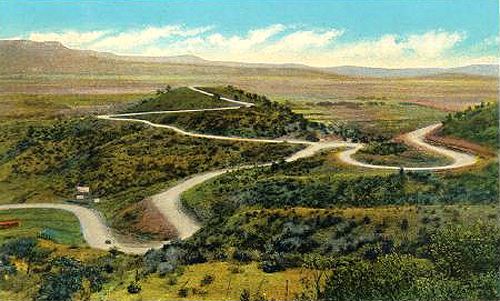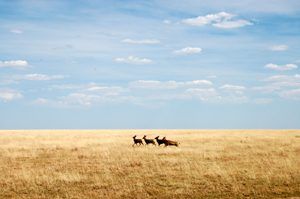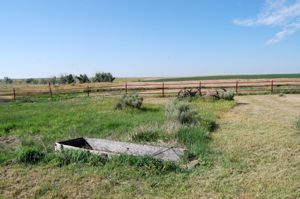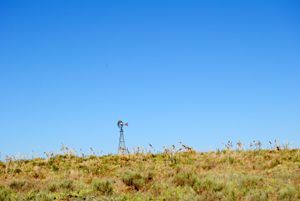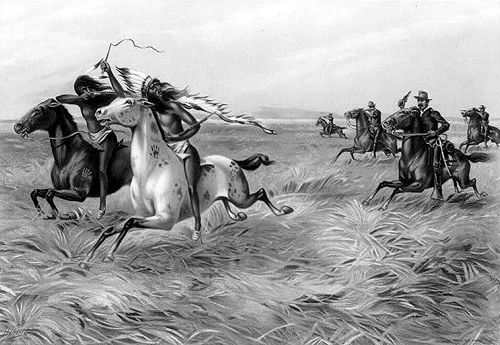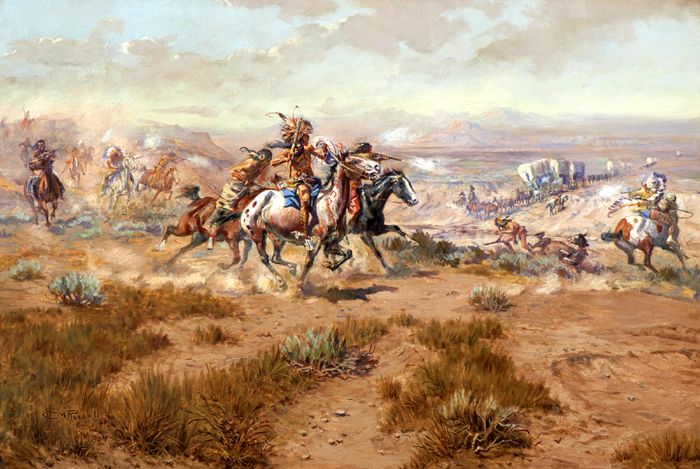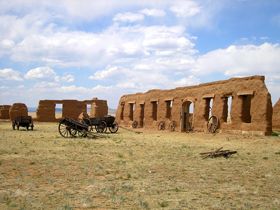Branches of the Santa Fe Trail – Legends of America (original) (raw)
Branches of the Santa Fe Trail
~~
The historic trade route of the Santa Fe Trail from Missouri through Kansas to Santa Fe, New Mexico, had two primary branches — the Cimarron Route and the Mountain Route. During the trail’s heydays, both were well-traveled for different reasons.
William Becknell blazes the Santa Fe Trail.
When William Becknell and his companions first blazed the Santa Fe Trail in 1821, they followed the north side of the Arkansas River, the international boundary between the United States and Mexico. After passing through Kansas and into eastern Colorado, they crossed the Arkansas River near its confluence to New Mexico. History has written that they then traveled over Raton Pass before making their way to Santa Fe, New Mexico. This route would become known as the Mountain Route of the Santa Fe Trail. That portion of the journey has been called into question after discovering the diary of Pedro Ignacio Gallego in 1993. Mexican Captain Gallego and his 400 men met Becknell on his first journey to Santa Fe. His writings, along with Becknell’s own journal describing the landscape, show more evidence that he and his men probably misidentified the Canadian River and instead crossed another river or stream. Researchers now say evidence points to a location between the Arkansas River and Puertocito Piedra Lumbre in Kearny Gap, south of present-day Las Vegas, New Mexico. Later, wagon trains would take the known Mountain Route.
However, on their return, the Becknell party took another route home to Missouri. This path went across eastern New Mexico into Oklahoma, then on into Kansas, where they crossed the Arkansas River back into the United States. This route would become known as the Cimarron Route or Cimarron Cutoff.
Raton Pass, New Mexico
Becknell’s first trip was such a success that he, along with 22 men, made a second trip in 1822. Loading three prairie schooners with goods, they decided to travel the Cimarron Route once again, knowing that their wagons couldn’t cross the mountains.
Though there were various paths and trails at different times throughout the history of the Santa Fe Trail, the journey was essentially the same until travelers reached western Kansas, in the area of present-day Cimarron, where the trail divided into two alternative routes — the Mountain Branch, following the Arkansas River further west to the site of Bent’s Fort, Colorado, south through Raton Pass into New Mexico; and the Cimarron Cut-off which, made a more direct diagonal route southwest through Oklahoma. The two paths rejoined in present-day Watrous, New Mexico, continuing southward to Santa Fe.
Cimarron Route:
The Plains of Southwest Kansas by Kathy Alexander.
The Cimarron Route, also known as the Cimarron Cutoff, and Cimarron Crossing, was the most favored in the earliest days of the Santa Fe Trail, even though the path was known for its scarcity of water. This route was shorter by about 100 miles, shortened the traveling time by ten days, and was more suited to wagon travel.
The Cimarron River, which gives the route its name, flows through southwestern Kansas and northeastern Oklahoma. Depending upon where the travelers left the Arkansas River, it was a journey of fifty or more miles to reach the Cimarron River. With poor grass and scant water, the sandy Cimarron River, which was often dry, defined the landscape as one of the riskiest sections of the entire Trail. This much dreaded, waterless area was often called the Cimarron Desert, Waterscape, and by the Mexicans, Jornada del Muerte, or Journey of Death.
Wagon Bed Spring Box on the Santa Fe Trail in Grant County, Kansas by Kathy Alexander.
The trail cut southwest across the Cimarron River valley near the town of Ulysses, Kansas, before finding its first reliable water supply since leaving the Arkansas River. Lower Cimarron Spring, also known as Lower Springs and Wagon Bed Springs, is on the north bank of the Cimarron River, approximately 11 miles south and 1.5 miles west of Ulysses, about two miles west of the markers on U.S. Highway 25 south of the Cimarron River bridge. Travelers breathed a sigh of relief upon finding Lower Spring as it meant they had survived. However, that would not be the case for all travelers, as near here, the famous hunter, trapper, and explorer, Jedediah Strong Smith, would lose his life. In 1831, Smith’s well-equipped wagon train became lost in the maze of buffalo trails. Seeking water for the dying animals and suffering men, Smith finally found the Cimarron River but was killed by the Comanche Indians near Wagon Bed Springs. His body was never recovered.
Cimarron National Grasslands, Kansas by Kathy Alexander.
The path then continued into Morton County, past Point of Rocks and through the Cimarron National Grasslands, which appear very much as they did during the Santa Fe Trail’s heydays. Following the Cimarron River, the trail then moved southward into present-day Cimarron County, Oklahoma, where it crossed the river at Willowbar Crossing and continued southwesterly to Cold Springs. There, Autograph Rock (on private land) still displays the names that scores of travelers carved into the ledges at the springs. The trail then passed by Camp Nichols, a short-lived military post established by Christopher “Kit” Carson in 1865. The trail exited Oklahoma, making its way into Union County, New Mexico. Subsequently, the trail passed by several historic sites and landmarks, such as Rabbit Ears Mountain, McNee’s Crossing, and Wagon Mound, before joining the northern branch at Watrous, New Mexico.
But, for the Cimarron Route, lack of water wasn’t the only problem. Another, often greater fear, was Indian attacks. Though the government had made treaties with the Kanza and Osage tribes in Kansas to guarantee safe passage, no such treaties were made with the Comanche, Kiowa, Cheyenne, Pawnee, and Apache had long roamed the Plains through which the Cimarron Cutoff was blazed. In the early days of trail travel, the Indians saw the travelers as more of a curiosity than anything else. At that time, they were generally content to allow passage in exchange for a few supplies.
U.S. Calvary chasing Indians
However, over time, this began to change as more and more people encroached upon their territory. Many Santa Fe traders began taking a second look at the Mountain Branch of the Santa Fe Trail, especially after the construction of Bent’s Fort along the Arkansas River banks near present-day La Junta, Colorado 1833. The dangers from Indian attacks got so bad that the Cimarron Cutoff was almost closed down in the 1840s.
Indian attacks all along the trail increased due to the Pike’s Peak gold rush in 1858 and by more and more settlers moving westward after the passage of the Homestead Act in 1862. The slaughter of Black Kettle’s band of Cheyenne by Colonel John Chivington’s Colorado Militia at Sand Creek in 1864 further angered the Plains Indians. In retaliation, Indian raiders began to roam all of the Santa Fe Trail west of Council Grove, Kansas, falling on scattered homesteads, killing travelers, and driving away livestock. In response to the increased Indian hostility, several forts were established, including Fort Larned in 1859 and Forts Zarah, Dodge, and Aubrey in 1864, all in Kansas.
Indian Attack on a Wagon Train by Charles Marion Russell
Realizing they were being driven out of their lands and believing that the white men had not fulfilled the terms of several treaties, the attacks continued. In 1867-68, some 210 people were killed by Indians in Kansas. Union Pacific Railroad tracks reached Sheridan, Kansas, in June 1868, and then westbound freight headed southwest over a wagon road to Fort Lyon, Colorado, on the main trail. The Cimarron Route was abandoned after that time, and most long-distance Mountain Route traffic ceased east of Fort Lyon.
There was the desert mirage, a will-o’-the wisp that beckoned and taunted. Sometimes it would look like a party of mounted Indians, and the women would cry and begin counting their children.— Marion Russell, on the Cimarron Cutoff, 1852
Mountain Route:
Though the Mountain Route of the Santa Fe Trail presented some problems, especially the crossing over Raton Pass, it most definitely had its advantages, including the fact that it had plenty of water and was relatively safe from Indian attacks. About 100 miles longer than the Cimarron Route, it became the favored route at various times due to drought and hostile Indian raids along the Cimarron Cutoff through the southwest corner of Kansas and the Oklahoma panhandle.
The Mountain Branch of the Santa Fe Trail continued to follow the Arkansas River from west of Dodge City through Gray, Finney, Kearny, and Hamilton Counties of Kansas. Through this area of southwest Kansas, several historic sites and Santa Fe Trail ruts can still be seen, including the Cimarron Crossing, a natural landmark called Indian Mound, the old fort Aubrey site, and more.
Bent’s Fort, Colorado by Kathy Alexander
The trail then made its way into Colorado, passing by Old Granada, Bent’s Fort, Boggsville, Fort Lyon, and the old Wooton Ranch, before making its way along the treacherous, steep, and unforgiving Raton Pass. Through here, wagons often had to be dismantled and hoisted over rocks and ledges, a process that could add days to the trip to Santa Fe. Early travelers observed broken remnants of wagons strewn all along the way over Raton Pass.
The Cimarron Cutoff became the most popular road to Santa Fe in the early years of the trail as it avoided Raton Pass and was more suited to wagon travel. It was also shorter by over one hundred miles, and if a savvy trader could beat his competition to Santa Fe, that only meant more profit. But the Cimarron Cutoff had its problems too. After crossing the Arkansas River west of present-day Dodge City, Kansas, it was a waterless route until the traders reached the Cimarron River (which could be dry too in certain years) furthermore, it went right through the heart of Comanche and Kiowa territory, making it more prone to Indian attack. However, the Mountain Branch became the favored route over the years due to the dramatic increase of Indian attacks caused by more and more people entering their territory.
Fort Union, New Mexico by Kathy Alexander.
The route of the Mountain Branch follows present-day I-25 over Raton Pass (along the railroad tracks). It parallels Highway 64 to Cimarron, New Mexico crossing in front of the Visitor Center and across the Cimarron River to Old Town. The two branches converged near the modern town of Watrous, New Mexico, and the sprawling complex of Fort Union. It then continued through several Hispanic settlements and the historic ruins of Pecos Pueblo, before it, at last, emerged from the passes of the Sangre de Cristo Mountains and into the Santa Fe Plaza.
Regardless of which path the travelers chose to take, they faced many hardships along the Santa Fe Trail. The caravans could not escape the harsh Plains, desert, and mountain elements along the 900-mile trek. These included dry spells, torrential rains, huge lightning storms, wolves, fires, and stampeding bison herds. Summers were very hot and dry, and the winters were often long and bitterly cold. Lack of food and water also made the trail very risky. River crossings were particularly troublesome. Although shallow, Plains rivers were filled with sinkholes, quicksand, and other hazards that required careful maneuvering.
In 1825, Congress voted for federal protection for the Santa Fe Trail, even though much of it lay in the Mexican territory. Though the Cimarron Route was much more prone to Indian attacks, raids intensified along the trail as the Native economies began to crumble, making the Santa Fe trade a dangerous business. Over time travelers began to use more oxen instead of horses and mules because the Indians did not want to risk raiding the caravans for only some oxen.
For years after the trail had fallen into disuse, it was marked by an unbroken string of destroyed wagons, animal remains, and the remains of old supplies.
© Kathy Weiser/Legends of America, updated October 2019.
Santa Fe Trail Wagon Sculture in Santa Fe, New Mexico, courtesy National Park Service
Also See:
Santa Fe Trail – Highway To the Southwest
“Uncle Dick” Wooton – American Frontiersman
Sources: See Santa Fe Trail Site Map & Writing Credits

